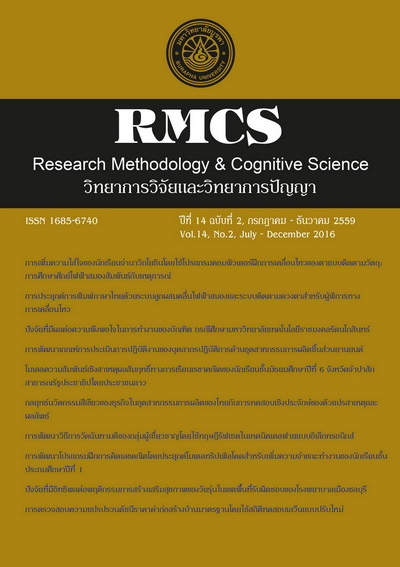การพัฒนาโปรแกรมฝึกการคิดเลขคณิตโดยประยุกต์โมเดลทริปเพิลโคดสำหรับเพิ่มความจำขณะทำงานของนักเรียนชั้นประถมศึกษาปีที่ 1
Main Article Content
Abstract
ความจำขณะทำงานเป็นทักษะทางปัญญาที่สำคัญสำหรับนักเรียน ซึ่งสัมพันธ์กับทักษะการเรียนรู้ สติปัญญา
และกระบวนการคิดวิเคราะห์ การวิจัยนี้จึงมีวัตถุประสงค์เพื่อพัฒนาโปรแกรมฝึกการคิดเลขคณิตโดยประยุกต์โมเดล
ทริปเพิลโคด สำหรับเพิ่มความจำขณะทำงานของนักเรียนชั้นประถมศึกษาปีที่ 1 และนำโปรแกรมที่พัฒนาขึ้นไปใช้
โดยพิจารณาจากการเปรียบเทียบคะแนนเฉลี่ยความจำขณะทำงานและคะแนนเฉลี่ยความสามารถด้านเลขคณิต
ระหว่างกลุ่มทดลองกับกลุ่มควบคุม และวิเคราะห์ความสัมพันธ์ระหว่างความจำขณะทำงานกับความสามารถด้านเลขคณิต กลุ่มตัวอย่างเป็นนักเรียนชั้นประถมศึกษาปีที่ 1 จำนวน 60 คน ที่กำลังศึกษาในภาคเรียนที่ 1 ปีการศึกษา 2558 โรงเรียนบ้านมะขาม (สาครมะขามราษฎร์) จังหวัดจันทบุรี จัดนักเรียนเข้ากลุ่มทดลองและกลุ่มควบคุม กลุ่มละเท่า ๆ กัน โดยการสุ่มอย่างง่าย เครื่องมือวิจัยเป็นแบบประเมินความจำขณะทำงานอย่างอัตโนมัติ (Automated Working Memory Assessment, AWMA) และแบบทดสอบความสามารถด้านเลขคณิต วิเคราะห์ข้อมูลโดยใช้สถิติ t - test
ผลการวิจัยปรากฏว่า
1) โปรแกรมฝึกการคิดเลขคณิตโดยประยุกต์โมเดลทริปเพิลโคด มีความเหมาะสมที่จะใช้ฝึกการคิดเลขคณิต
สำหรับนักเรียนชั้นประถมศึกษาปีที่ 1
2) ความจำขณะทำงานและความสามารถด้านเลขคณิตของกลุ่มทดลองหลังฝึกด้วยโปรแกรมฝึกการคิดเลขคณิต
ที่พัฒนาขึ้นสูงกว่าก่อนฝึกอย่างมีนัยสำคัญทางสถิติที่ระดับ .01
3) ความจำขณะทำงานและความสามารถด้านเลขคณิตของกลุ่มทดลองที่ฝึกด้วยโปรแกรมฝึกการคิดเลขคณิตที่
พัฒนาขึ้นสูงกว่ากลุ่มที่ไม่ได้ฝึกอย่างมีนัยสำคัญทางสถิติที่ระดับ .01
4) ความจำขณะทำงานกับความสามารถด้านเลขคณิตหลังฝึกด้วยโปรแกรมฝึกการคิดเลขคณิตมีความสัมพันธ์
กันทางบวกอย่างมีนัยสำคัญทางสถิติที่ระดับ .01 (r = .94, p < .01)
Working memory is an important cognitive skill for students that related to learning skills, intelligence, and thinking process. The objectives of this research were to develop an arithmetic training program based on Triple Code Model for enhancing the grade one students’ working memory to consider the results of the developed program by comparing the average working memory scores and the average arithmetic ability scores between the experimental and control groups to analyze the correlation between working memory and arithmetic ability of the experimental aftertraining with the developed program. The participants were sixty grade one students who were studying in the first semester of the academic year 2015, Makham School (Sakorn Makhamrat) Chanthaburi Province. They were randomly and equally assigned to experimental and control groups. The research instruments were Automated Working Memory Assessment (AWMA) and the arithmetic ability test. T - test was used to analyze the data.
The results were as follows:
1) An arithmetic training program based on Triple Code Model is suitable for training the grade one students.
2) The average scores of working memory and arithmetic ability of the experimental group after training with the developed program were significantly higher than before training (p <. 01).
3) The average scores of working memory and arithmetic ability in the experimental group were significantly higher than the control group (p <. 01).
4) Working memory and arithmetic ability in the experimental group after training with the developed program had a positive and significant relationship (r = .94, p < .01).
Article Details
References
Alloway, T. P. (2007). Automated working memory assessment. London, England: Pearson Assessment.
Alloway, T. P. (2007). Working memory, reading and mathematical skills in children with developmental coordination disorder. Journal of Experimental Child Psychology, 96, 20–36.
Alloway, T.P., Bibile, V., & Lau, G. (2013). Computrized working memory training: Can it lead to gains in cognitive skill in student?. Computers in Human Behavior, 29, 632–638.
Aydin, K., Ucar, A., Oguz, K.K., Okur, O.O., Agayev, A., Unal, Z., Yilmaz, S., & Ozturk, C., (2007). Increased gray matter density in the parietal cortex of mathematicians: a voxel-based morphometry study. Journal of Neuroradiol, 28, 1859–1864.
Baddeley, A. (2000). The episodic buffer: A new component of working memory?. Trends in Cognitive Sciences, 4, 417–423.
Baddeley, A. (2002). Is Working Memory Still Working?. European Psychologist,7(8), 5-97.
Baddeley, A., Eysenck, M.W. & Anderson, M. (2009). Memory.New York: Psychology Press.
Bayliss, D. M., Jarrold, C., Baddeley, A. D., & Leigh, E. (2005). Differential constraints on the working memory and reading abilities of individuals with learning difficulties and typically developing children. Journal of Experimental Child Psychology, 92, 76–99.
Campbell, J. I. D. (2005). Handbook of mathematical cognition. New York: Psychology Press.
Dahlin, E., Nyberg, L., Backman, L., & Neely, A. S. (2008). Plasticity of executive functioning in young and older adults: immediate training gains, transfer, and long-term maintenance. Psychology and Aging,
(4), 720-730. doi:10.1037/a0014296
Dehaene, S. (1992). Varieties of numerical abilities. Cognition, 44(1-2), 1-42.
Dehaene, S., & Cohen, L. (1995). Towards an anatomical and functional model of number processing. Mathematical cognition, 1(1), 83-120.
Dehn, M.J. (2008). Working memory and academic learning assessment and intervention. U.S.A.: John Wiley & Sons, Inc.
Imbo, I. & Lefevre, J.A. (2010).The role of phonological and visual working memory in complex arithmetic for Chinese-and Canadian-educated adults. Memory & Cognition, 38(2), 176-185.
Lee, Y. S., Lu, M. J., & Ko, H. P. (2007). Effects of skill training on working memory capacity. Learning and Instruction, 17(3), 336-344.
Swanson, H. L. (2004). Working memory and phonological processing as predictors of children’s mathematical problem solving at different ages. Memory & cognition, 32(4), 648-661.
Zhou, X. (2011). Operation-specific encoding in single-digit arithmetic. Brain and Cognition, 76(3), 400–406.

